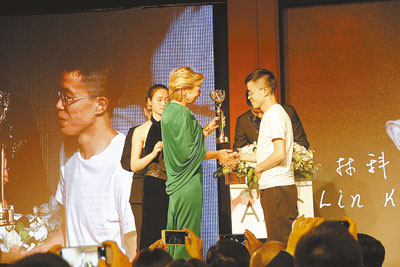 Debra Li Debra_lidan@163.com THE Award of Art of China (AAC), one of China’s most influential art awards that tracks and recognizes the best in contemporary Chinese art, held its 9th annual award ceremony in Beijing last week to honor the most influential figures and publications of 2014. Zhang Peili, known as the “Father of Chinese Video Art,” was named 2014’s AAC Artist of the Year. Huang Zhuan, an associate professor at the Guangzhou Academy of Fine Arts and a jury member of the AAC, said Zhang’s works unveiled the paradoxical relationship between humans and the world. “His audio installations, featuring crescendos and fading out noises, depict the communication conflicts and anxieties of our era,” he explained. Accepting his award at a ceremony at the Jianfu Palace Garden inside the Forbidden City on Thursday evening, Zhang said he was flattered that his rule-breaking art spanning three decades was being recognized beyond his expectations. Zhang, born in 1957 and graduating from the Zhejiang Academy of Art in 1984, debuted his first video artwork — and the first video art piece in China — “30×30” in 1988 and has since devoted his career to video and installation art. Repetitive and mechanical motion is a major feature of Zhang’s early video artwork. With the advancement of technology, Zhang’s videos started to present more layers and dimensions. After making a number of video series, Zhang gradually moved from making original works to using existing videos and movies as raw materials. Since 2005, he has been incorporating an increasing amount of interactive technology. The slow-motion shots in his 2008 work “A Gust of Wind” marked his first experimentation with film esthetics while his 2014 piece “Harmony of Clash” announced his foray into audio installations. Lin Ke, born in the 1980s, received the 2014 AAC Young Artist of the Year Award from Philip Tinari, director of the Ullens Center for Contemporary Art. “Trading in strokes and colors for digital imagery, Lin’s work simulates the reality in a classically realistic style. Both its intricate visual impact and logical structure are fascinating, calling into mind our myriad imagining of the relationships between nature and artificiality, reality and the virtual world, transcending the meaning of the image itself,” Tinari said at the award ceremony. Through Lin’s work, the audience can sense the loneliness of a young man in the digital age, his struggles to retain his humanity and the instinct to reach out to others. “To be honest, most of my past works aren’t exactly art, but a form of interaction. They don’t necessarily form a relation with the physical world, as they were realized in the virtual world of the Internet,” Lin said after winning the award. A graduate of the New Media Department at the China Academy of Art in 2008, Lin won the OCAT-Pierre Huber Art Prize in 2014. Last year, he held a solo exhibition at Gallery Yang, displaying a series of photography and video works. Lin’s works collect the mundane, nonsensical yet extremely real scenarios of modern daily life in the digital world and present them in an interesting, cheerful way. He has also made his past discoveries and research on digital imagery and the Internet into a 60-minute film. Instead of picking an art publication of the year, AAC lauded four books and a journal on a “recommendation” basis. These include “A History of Exhibitions: Shanghai 1979-2006,” “Contemporary Chinese Art: A Critical History,” “Contemporary Chinese Art,” “On Radical Art: The 80s Scene in Shanghai” and “Journal of Contemporary Chinese Art Studies.” “This award is not merely about evaluating the publications, but also encouraging more people to study contemporary Chinese art because art and in-depth and consistent studies of art thrive on each other’s success,” said Zhu Qingsheng, art historian and professor at Beijing University. AAC was established in 2006 by Artron.net. | 
